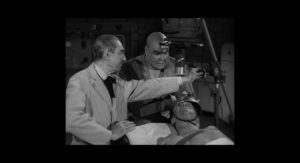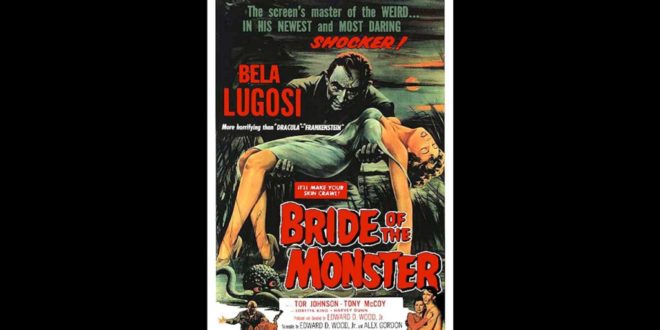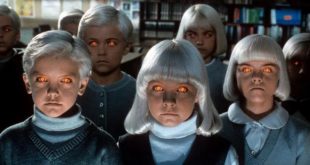Ed Wood’s 1955 sci-fi horror film, Bride of the Monster, may be silly, but it said a lot about mankind’s future. Yes, I’m being serious! If you don’t believe me, keep reading.
“Home? I have no home. Hunted, despised, living like an animal! The jungle is my home. But I will show the world that I can be its master! I will perfect my own race of people. A race of atomic supermen which will conquer the world!”
— Dr. Eric Vornoff (Bela Lugosi)
Every time a movie like this comes along, it’s almost begging to be snickered at. Even in the 1950s when special effects were generally an undeveloped art, some films looked better than others. Still, Bride of the Monster proves that looks aren’t everything. This movie has charm as well as a surprising amount of food for thought — especially when placed in greater context.
Imagine you’re alive in the 1950s at the height of the Cold War. Your life may be great, terrible or somewhere in between, but there’s one little problem: It can be snuffed out in the blink of an eye! One atomic explosion and it’s Pompei time, and no amount of “Duck and Cover” propaganda can change that.
This is the political backdrop of Bride of the Monster — and boy, does it show! Even when the sinister Dr. Vornoff or Lobo (played by Ed Wood favorite Tor Johnson) aren’t on screen, there’s a weird sort of tension. Sure, it may be partly due to Wood’s mystifying style of direction, but it definitely feeds into the more dramatic aspects of the story.

Biblical Dimensions?
Hell, the cheesy effects in Bride of the Monster could almost be considered symbolic, like the snake in the tree scene featuring Janet Lawton (Loretta King). The Bible famously features a snake in a tree as one of the great origin stories in literature. The tree of knowledge contains forbidden fruit, which leads to man’s downfall. As weird as it sounds, there’s no doubt in my mind that Wood — who added an intellectual dimension to his sci-fi shlock — loved such parallels. For the snake to be noticeably rubbery and lifeless only adds comment. I’m not quite sure what it says, but the snake prop likely says something about man versus nature. In his quest for knowledge, man must essentially conquer nature, and conquer himself in the process. Sure enough, the film’s final quote, said by Captain Tom Robbins (Harvey B. Dunn), is, “He tampered in God’s domain!”
So, not only did this movie express fear of nuclear obliteration, but of a general disdain we have for leaving anything alone. Ed Wood seems to ask: Must we uncover every truth, study every little thing? Curiosity may have killed the cat, but it has a proven ability to kill the human as well.
Vornoff’s Shadow: Knowledge Corrupts Man

One needn’t be Christian to challenge man’s quest for knowledge. Far from it! In fact, such questions may be better reserved for hardcore atheists, precisely because they don’t believe in the afterlife. Knowledge can indeed lead to insanity and violence, which Wood emphasizes here.
At one point, Dr. Eric Vornoff says, “One is always considered mad if one discovers something that others cannot grasp!” For him, the challenge of surpassing taboos is its own motivator, in addition to his basic drive for revenge. Now, if you look at which image motivates most zealous movers and shakers, quite often, it is that they wish to be seen as renegades.
“I was classed as a madman, a charlatan, outlawed in a world of science which previously honored me as a genius. Now here in this forsaken jungle hell I have proven that I am all right…” — Dr. Eric Vornoff
Homicidal ambitions aside, Vornoff might have fit right in with Apple’s 1997 Think Different ad campaign, which said: “Here’s to the crazy ones, the misfits, the rebels, the troublemakers, the round pegs in the square holes … the ones who see things differently. They’re not fond of rules, and they have no respect for the status quo. They push the human race forward, and while some may see them as the crazy ones, we see genius, because the people who are crazy enough to think that they can change the world are the ones who do.”
In many ways, technology did conquer the world, and now the crazy ones and rejects are seen as the conformists. Sure, we didn’t end up with atomic supermen, but governments did conduct nuclear tests without much regard to their consequences. There were also unethical medical experiments on people throughout history, and Vornoff undoubtedly represented the war industry — which the world certainly has.

Also, going back to cellphones (which people often stare into like the abyss), George Monbiot of The Guardian was being fair when he wrote in an article, “My search for a smartphone that is not soaked in blood…” In other words, good luck finding a phone that isn’t linked to sweatshops, hazardous waste and violent regimes.
Granted, I doubt Steve Jobs kept a giant octopus or planned to create a race of atomic supermen. However, I find this all shockingly relevant to a character like Dr. Vornoff, who was Ed Wood’s quirky warning about the domineering dangers of innovation.
I know, I know — I’m reading too much into a cheesy old Ed Wood movie! What the hell’s wrong with me? Well, think of it this way: When Vornoff whips the sweet hell out of poor Lobo, is it not a bit like grueling sweatshop conditions? Part of what makes mad scientists so very mad are their egos, and an inability to consider the consequences of their actions.
How about you? What are your thoughts about Bride of the Monster as a serious film? Let us know in the comments!
 PopHorror Let's Get Scared
PopHorror Let's Get Scared




